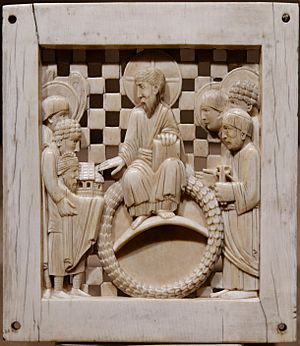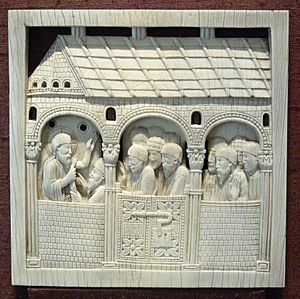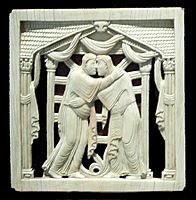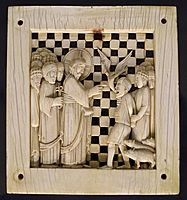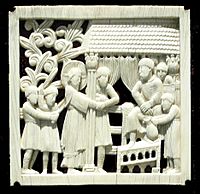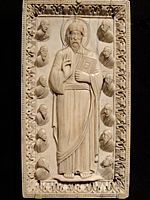Magdeburg Ivories facts for kids
The Magdeburg Ivories are a collection of 16 ivory panels that show different moments from the life of Jesus Christ. These panels were ordered by Emperor Otto I. They were likely made to celebrate the opening of the Magdeburg Cathedral and when Magdeburg became an important church center (an archbishopric) in the year 968.
These panels were once part of a larger object in the cathedral. People have guessed it might have been a special front for an altar, a throne, a door, or a pulpit. This object is often called the Magdeburg Antependium. It is thought that this object was taken apart or destroyed sometime after the year 1000, maybe after a fire in 1049.
Many believe the ivories were made in Milan, which was a major city for art and politics in the Holy Roman Empire at that time. However, some art experts, like Peter Lasko, think they might have been made by artists from the Lorraine area, possibly in Metz, because of their unique style. The Magdeburg Ivories are a key example of Ottonian art. They show the Ottonian style in sculpture, which is more often seen in old illustrated books.
Contents
What Do the Ivories Look Like?
Each ivory panel is about 13 centimeters (5 inches) tall and 12 centimeters (4.7 inches) wide. They are special because they combine carved figures with an open, see-through background. The backgrounds have different patterns like leaves, checkerboards, or crosses. Some even show buildings behind the people. In other scenes, there are so many figures that there is no space for decorations. The open parts of the ivories probably showed a shiny gold or gilded (gold-covered) surface behind them.
We know about two more panels from drawings made in the 1500s. The original collection was probably much larger. Many common stories from the Life of Christ are missing from the surviving panels. One expert, Peter Lasko, thinks that less than half of the original panels still exist. He suggests that because many of the remaining panels show stories from Jesus's time teaching, they might have decorated a pulpit (a raised platform where sermons are given) rather than an altar.
Where Are the Ivories Now?
After the original object was taken apart, the Magdeburg Ivories were reused in other church items, like special boxes for holy relics or covers for important books. Today, they are spread out in nine different museums around the world.
The Berlin State Library has four panels. The World Museum in Liverpool and the Bavarian National Museum in Munich each have three. The Louvre in Paris has two. Single panels are found in the Musée Antoine Vivenel in Compiègne, the Hessisches Landesmuseum Darmstadt in Darmstadt, the British Museum in London, and the Metropolitan Museum in New York. The four panels in Berlin are part of a valuable book cover from the 900s called the Codex Wittekindeus. All the other panels are shown as individual art pieces.
Who Made Them?
Experts agree that all the panels came from the same workshop. However, you can see the work of different artists in the collection. For example, the panels in Liverpool and Paris were made by different people.
There is also another ivory panel, not from the Magdeburg set, but believed to be from the same workshop. This panel is now in the Cleveland Museum of Art. It shows a standing Christ with the heads of his Apostles appearing from the background. This panel was likely always meant to be part of a book cover.
Gallery
-
The Visitation, Bavarian National Museum
-
Christ before Pontius Pilate, and Flagellation of Christ, Bavarian National Museum
List of the Panels
Here is a list of the surviving Magdeburg Ivories and what they show:
- Dedication scene: Christ receiving the cathedral from Emperor Otto I (now at the Metropolitan Museum of Art)
- Traditio legis: Christ giving the Law to Peter and Paul (Berlin State Library)
- Visitation (Bavarian National Museum, Munich)
- Finding in the Temple (Berlin State Library)
- Jesus heals a possessed man from Gerasa (Hessisches Landesmuseum Darmstadt)
- Jesus performing miracles (Berlin State Library)
- The second Miracle of Loaves and Fishes (Louvre, Paris)
- Peter finds tribute money in a fish's mouth (World Museum Liverpool)
- Jesus blesses a little child (Louvre, Paris)
- Raising of the son of the widow of Nain (British Museum)
- Jesus in the House of Simon the Pharisee (Musée Antoine Vivenel, Compiègne)
- Jesus and the woman taken in adultery (World Museum Liverpool)
- Raising of Lazarus (Berlin State Library)
- Flagellation and judgment of Jesus by Pilate (Bavarian National Museum, Munich)
- Christ appears to Doubting Thomas and the other apostles (Bavarian National Museum, Munich)
- Christ Commissioning the Apostles (World Museum Liverpool)


